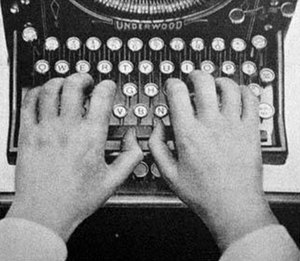 |
| Image via Wikipedia |
Writers are a funny bunch. We each have our own self-imposed
rules, routines, favourites and hates. I know of authors who can no more create
at the keyboard than they can lay an egg. But my method of composition now depends
utterly on the keyboard. This is despite the fact that I can't touch type and
use only two fingers (not those two!) and a thumb (either will do, I'm not
prejudiced). I have to look at the keyboard as I write and then glance at the
screen, with Word's spelling correction thingy open so it underlines any typos
I make as I go along. I make a lot of ytops so I really should do something
about it.
I should learn to touch type, of course.
In fact, I spent a fortnight doing just that, about 700 years
ago, on a manual typewriter, and became quite proficient by the end of the
course. Unfortunately, events jumped up and down on my ambition at the time
and, having finished the course, I never went near a keyboard again for over two
years. By that time, I'd forgotten everything I'd learned and went back to my
three digit approach. It's not too bad; I can manage about 45 words a minute,
when I'm really going. But I'd be much better off if I could touch type. One
day, perhaps…
I don't dare write in script. I was clearly meant to be either
a genius or a doctor, because my handwriting is all but indecipherable, even to
me! Where did it all go wrong? The bit about being a genius or a doctor, I
mean. As for the handwriting, well I have a small excuse that I was one of the
lucky few who, following the end of World War II (I'm not that old that I have
any personal connection with WWI), I was part of the generation who went to
school during the continuing paper shortage. So, I learned to write, at age five,
using a framed slate panel and a lead scriber. We complain about Health and
Safety rules these days, but at least our kids don't learn using intimate
contact with poisonous metals, eh? I was still in the early days of this
initial learning when I contracted Scarlet Fever. I recall the ambulance, with
its ringing bell (yes, a bell, not a siren) rushing me to the local hospital on
Christmas Eve. There, I spent six weeks in an isolation ward, along with
umpteen other patients, of all ages and both genders, suffering other
contagious illnesses. Another six weeks off school, after I was discharged,
meant I'd fallen seriously behind my fellow pupils when I returned to school a
few weeks before my sixth birthday. I never caught up. So, that's my excuse for
the poor handwriting.
But, in spite of my dyslexic fingers, the keyboard serves me
well. Thank heavens for the speedy ability to right wrongs there. I repair
spelling errors on the fly, but never actually read what I've written until I
reach the end of a piece, no matter whether that piece is a tweet, a short
story or a novel. Then I return to the beginning and correct, edit, replace and
cut wherever necessary. Unlike many writers, I actively enjoy the editing
process. The creative part, which I do at tearing pace, flying through the
paragraphs like a demented racehorse set free from its jockey, I love. The
making up of lives, events, lands, and all the other story elements feeds that
part of me where the imagination dwells.
In my early days, I did actually write in longhand and then
transposed the work to type on a manual typewriter; a process that took more
time than the composition, usually because I couldn't read my own writing and
had to decipher words to make sense of it. I used the less than perfect Tippex
to deal with the odd typo. Later, I progressed to an electronic machine with a
correction ribbon; a real boon. But, in those days before the word processor
and computer printer, any re-arrangement of a sentence involved retyping an
entire page and, sometimes, an entire chapter. Publishers required pristine
text without alterations, so it could take a long time, much patience, and an
entire forest to turn out a manuscript that an agent or editor would accept.
Paper wasn't generally recycled back then, so the waste bin
overflowed with screwed up pages. These days, we wait until everything appears perfect
on the screen before committing the work to paper. But even that isn't
foolproof: every writer understands that editing on paper is far more likely to
throw up errors than doing the same job on the computer screen. But, at least,
it's simpler to correct now, and it isn't often necessary to reprint the entire
work simply because of a few errors.
So, I compose at the keyboard, correct on screen, print in
draft and re-edit using a pen, and then I transfer the changes to the file and
reprint in 'best' mode to send my work off to editors and agents. I print, as
required by the industry, on one side only of the paper, with wide margins. I
mean, what's it matter if I still use a forest to achieve this level of perfect
presentation? All that matters is that the reading professional will have no reason
to reject the piece without even bothering to read it. After all, competition
is tough out there. It's good to know that they'll have a pristine piece of
work to view before they reject it without reading; makes the whole process so
much more worthwhile, don't you think?
